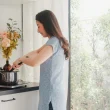Whenever you’re roasting a beef joint, you’ll probably be wondering how long to cook 0.9kg of meat. A topside joint is a good choice as it’s cheap and works well in a roasting tin. Here are some tips for roasting this cheap joint. Ensure you choose a roasting tin that is slightly larger than the joint itself. A large tin will evaporate the gravy’s juices. In addition to the beef, roasting tins can be complemented by peeled and halved onions and sprigs of herbs. Caramelising onions will give the gravy extra flavour.
Topside beef is a cheap joint that works well for roasting
If you are looking for an affordable beef roast, consider trying a topside beef joint. These beef joints can be roasted to perfection and come with tasty beef gravy. Topside beef is relatively lean, but the fat on top makes it moist and tender during cooking. It should be roasted for about 1 hour 15 minutes to be tender and juicy. Usually, you can get a 1.5 kg topside beef joint at a supermarket.
Before roasting a beef joint, you should weigh it. Then, multiply the weight by the recommended cooking time. This should give you an approximate time for each 450g of beef. To cook a beef joint to rare or medium rare, you should cook it for 20 minutes per 450g plus 25 minutes. If you want it to be well-done, roast it for at least 30 minutes more.
Basting a roasting tin
Before you start roasting a 0.9kg beef joint in a roasting tinned, you should weigh it. This will help you gauge how long to cook it. If the joint weighs more than 450g, cook it for 20 minutes on a high heat before reducing to a lower temperature. Remove the foil before cooking so that the meat can rest for a few minutes. After cooking, serve the roast beef with gravy.
To check whether it’s done, pierce it with a skewer. If the juices run clear or red, the beef is well done. Place the beef, fat side up, in the roasting tin. Be sure to keep the string or netting attached. After a couple of hours, uncover the beef and baste it with pan juices.
Roasting on a high heat
To cook a perfect roast beef joint, start by weighing the meat and then wrapping it in foil. It should be rare, medium or well-done. When buying a beef joint, make sure it has a uniform color and plenty of marbling. You also want the fat to be white or cream-coloured. Lastly, make sure to prick the meat with a skewer so you can check its internal temperature. If it reads 40C, then the beef is well-done. If it’s not, remove it from the oven and let it rest for at least 20 minutes before carving. Once rested, you can make gravy and serve the beef.
When cooking beef, the temperature must be right. Large roasting joints need about 20 minutes on high heat, while smaller ones need about 15 minutes on low. Afterwards, leave the oven door open for a few minutes so that the beef can rest and cool. The meat should be basted with the sauce in the pan throughout the cooking process. The water should be added to the pan as needed.
Resting a beef joint
Before roasting a 0.9 kg beef joint, it is recommended to weigh it. This will help you determine the amount of time to cook it. For example, if your joint weighs about 2kg, it will take about 25 minutes to cook it to medium. If your joint weighs about 3kg, it will take about 40 minutes to cook. Ideally, you should rest the joint for at least 30 minutes before slicing it and serving it with sides and gravy.
For a medium rare or well-done beef, you can skewer it to check for doneness. The juices should run clear or pink but not completely. The final internal temperature is directly related to the doneness of the meat. Knowing when to pull the beef from the heat is essential for getting the best results. To do this, use a meat thermometer. Place the probe near the centre of the meat and away from bones. Leave it for 20 seconds to get a reliable reading. A 50C reading means the beef is medium rare, 60C is medium, and 70C is well-done.
Podobne tematy




